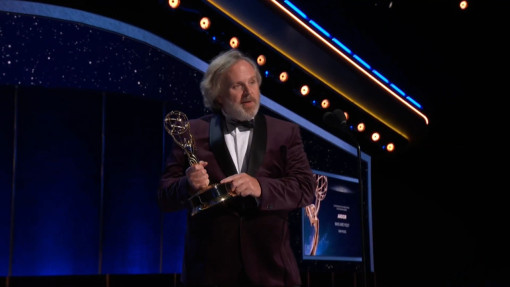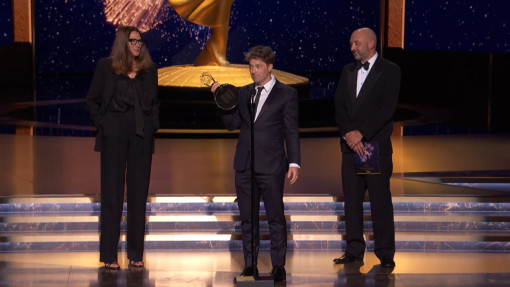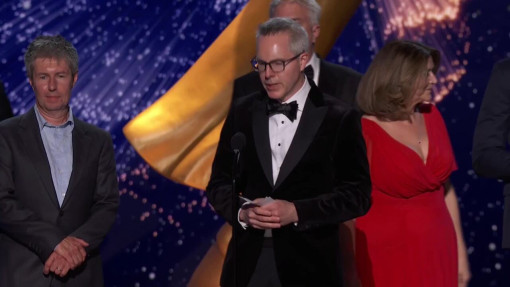Ironically, the last image from Andor’s series finale was one of the first things that showrunner Tony Gilroy imagined.
“That shot came to me pretty early on,” Gilroy tells the Television Academy two weeks before his Emmy-nominated Star Wars series from Disney+ signs off from its two-season run in that galaxy far, far away. “It’s really about hope.”
It’s hope that Gilroy wants audiences to take with them as his prequel to the events of 2016’s blockbuster film Rogue One wraps up its final season. The second season devotes four, three-episode blocks chronicling the Empire’s fascist conquest of the galaxy as the nascent — and, at times, disorganized — Rebellion struggles to stop its progress. Thematically, hope is a challenging thing to pull off when audiences already know the fate of the show’s titular character, Cassian (Diego Luna): He sacrifices himself while trying to stop the completion of the Death Star, which also leads to the death of a whole planet in the very first installment of the iconic sci-fi saga, the 1977 film Star Wars: A New Hope, written and directed by its creator, George Lucas.
But for Gilroy, knowing the fate of one of the franchise’s most complex and compelling anti-heroes doesn’t negate the emotional investment audiences have with those Cassian leaves behind — namely, his friend and lover, Bix (Adria Arjona), and their newborn child. A child that, sadly, Cassian will never see. The show ends on an image of Bix standing in a wheat field on Mina-Rau, a planet central to season two’s plot, cradling the infant close to her chest as she stares off into the distance with a conflicted expression.
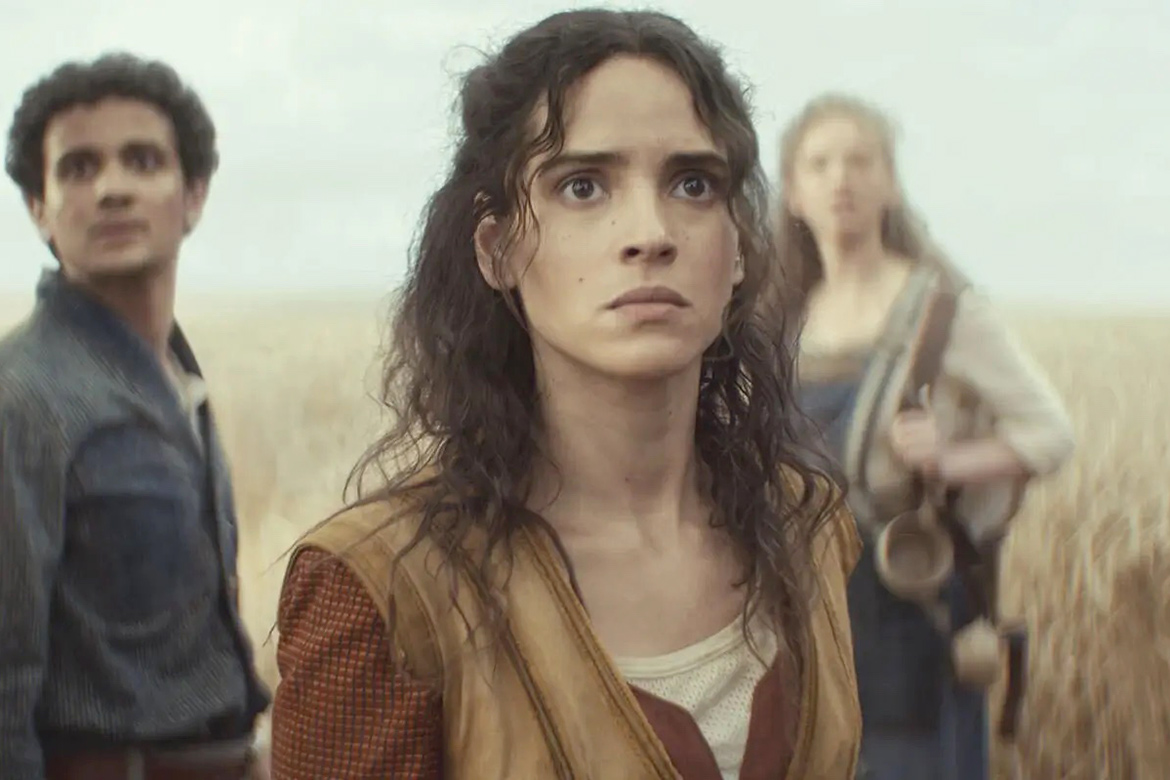 Bix (Adria Arjona) on Mina-Rau in Andor / Photo credit: Disney+/Lucasfilm
Bix (Adria Arjona) on Mina-Rau in Andor / Photo credit: Disney+/Lucasfilm
“It’s bittersweet,” Gilroy says. “That shot does a bunch of things for me. For anybody who was confused by what Bix is saying in [episode] nine, about why she's leaving, it's pretty complicated why she's leaving. She’s basically saying, ‘My boyfriend has a destiny that's really important, and I might be in the way. I love him so much, so I’m going to leave.’”
According to Gilroy, Bix’s choice, and its impact on Cassian, is an intentionally heartbreaking one. “It just makes his sacrifice in Rogue that much more epic. I mean, the child he's never going to meet and all the lost opportunities that come with that. And that feeds into the line in Rogue — “rebellions are built on hope.” And that's not bullshit. I mean, that has to be true if I did not want the show to be about hopelessness. I cannot grind all these people down the way I want to grind them down if I'm not going to put a candle at the end of the highway there. So it's really about hope."
Gilroy first conceived the show’s final moments when writing what he calls “the head and the tail” to each block of episodes in order to prove that the show could not only earn this moment, but also deliver on everything else building up to it. With an ambitious narrative spine for department heads to hang their work on, Gilroy and his writers’ room — which included Beau Willimon (House of Cards); Tony’s brother, Dan Gilroy (Nightcrawler); and Tom Bissell (The Mosquito Coast) — fleshed out their scripts. In doing so, Gilroy reveals that a pivotal storyline in episode three required some convincing among stakeholders. It centered on Senator Mon Mothma (Genevieve O’Reilly), the burgeoning Rebel figurehead forced to order a hit on her childhood best friend, Tay Kolma (Ben Miles), when he and his efforts financing the Rebellion become a liability to their cause.
“There was a lot of doubt about that,” Gilroy explains. “I would say that of the 10 or 11 things, or whatever, that people were skeptical about, that [storyline] would probably be really high on the list. They thought, ‘Is it really going to be believable that [Tay] has changed that much in all this time?’ And I was like, ‘Yeah.’ Because we all have known people that we thought really had it together, and then you see them years later, and you’re like: ‘What has happened to you?’”
Gilroy credits Miles for helping convince the skeptics, who quickly found themselves on the showrunner’s side when dailies came in for the third episode. “Ben really helped me out. He is a brilliant actor. And I was like, ‘If Tay hadn't been a co-conspirator, killing him probably would have been a lot harder.’ But Ben wanted to do it, too. I think by the time we got to the cutting room, we were committed that we were going to make it work.”
A different kind of skepticism surrounded two other key Andor characters: Luthen Rael (Stellan Skarsgård), the secret mastermind behind the Rebellion’s early days, and his cunning spy in training, Kleya Marki (Elizabeth Dulau). Their mentor-mentee relationship was, initially, a challenging needle to thread.
“That would be another plot or storyline on the controversial level within our company,” Gilroy recalls. “The question was: ‘Can we really do this?’ Because I can't have a show where there's an older guy who's manipulating a young woman into being a terrorist. I can't have that. Can’t do it.”
Throughout the writing and filming of season one, Gilroy was concerned that audiences were going to “misinterpret the relationship in some way.” As a precaution, he was especially careful about the staging of their interactions; he made sure there was no touching or physical contact that could be deemed questionable or problematic. But, as with Tay Kolma’s fateful arc, Gilroy once again was able to dispel any doubts caused by the character thanks to the actor playing him.
“What we found is what Stellan realized: That Luthen’s just been terrified of her from the very beginning. [Stellan] is really the authority there. Luthen was never really in charge, she’s always been in charge. Once he shared that, that helped everybody get over that hump.”
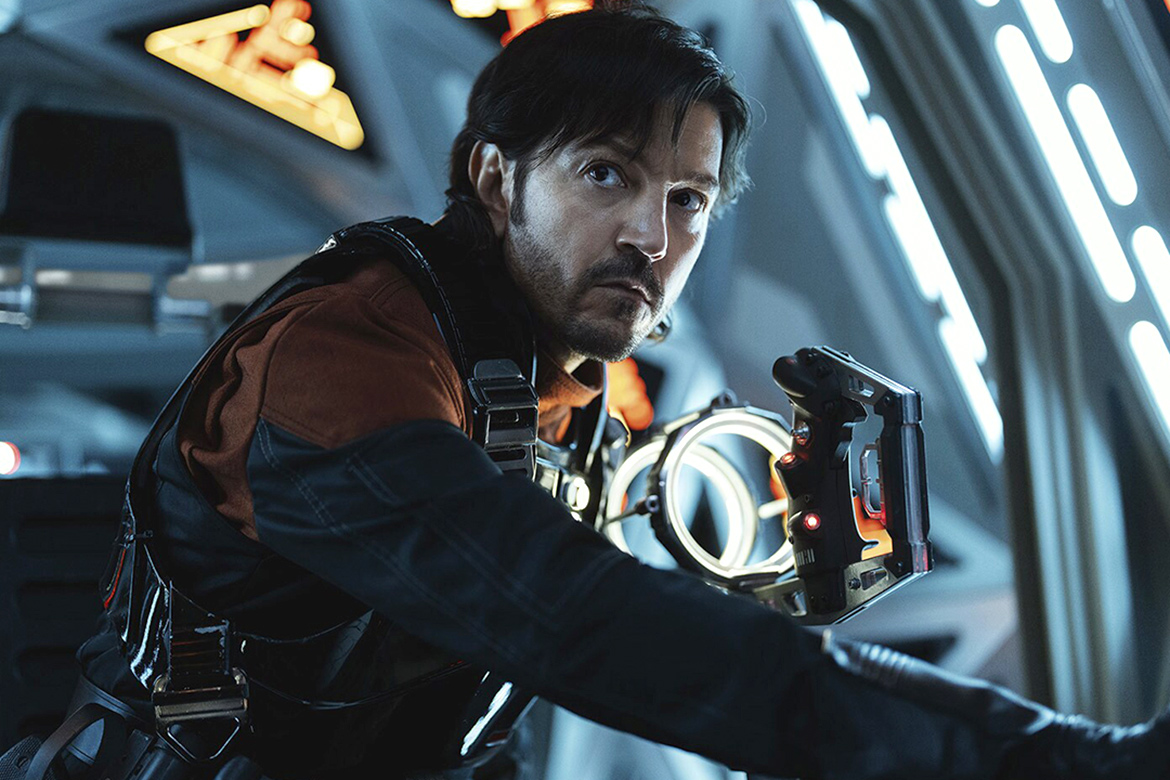
It’s a good thing, too, because their dynamic provides Andor — and Star Wars in general — with one of its most heartbreaking scenes. In the last block of episodes, Luthen is captured after trying to take his own life. He is rushed to an Imperial medical facility that Kleya infiltrates. There, she takes out a few Imperial personnel before ending the life of the closest thing she has to a father figure. “I don’t think he could do that for her,” Gilroy says.
Gilroy also doesn’t think a project has ever challenged or changed him as a writer like Andor did.
“I became just so much a better writer than I was before. I mean, in every way,” he says. “You’re just writing constantly every day, so you’re in shape. Everything that's coming off your desk is being shot. It starts with all the raw material, and then it goes to the writers’ room. Then, they get their drafts, and they do their stuff, and then we sit with it for months and months and months.”
Andor’s production needs also contributed to the enhancement of his skillset: “Some of it changes because of the budget, and then I just weave my way through it. I'm rewriting all my shit. I'm rewriting all their shit. But when it comes off my desk, finally, that's what's being shot. You're just writing for people that you know. You're writing for actors that you love, that you've learned to write for, and you don't have to establish the characters. You can just go right to work. So that's an advantage. It's getting to see it and hear it and live it that makes you better.”
This interview has been edited for length and clarity.
Andor is now streaming on Disney+.







